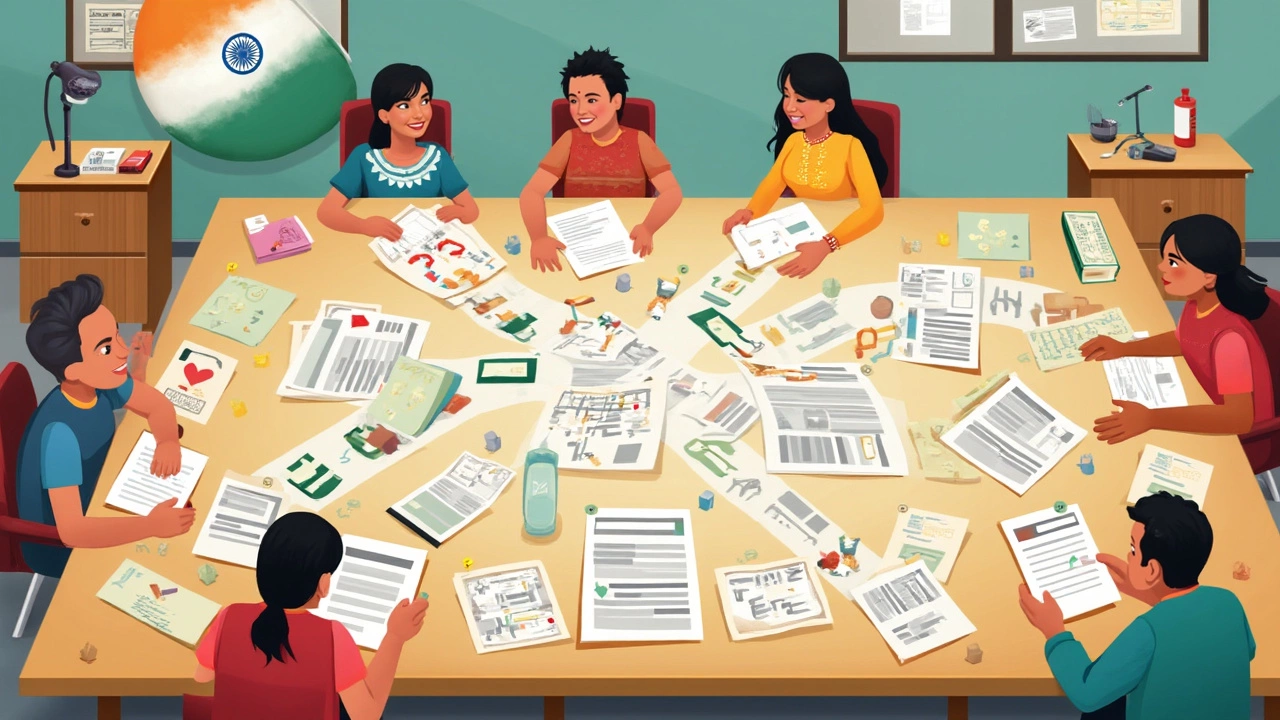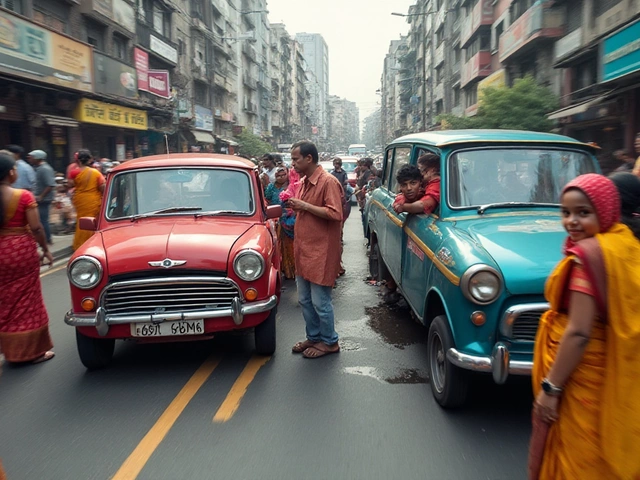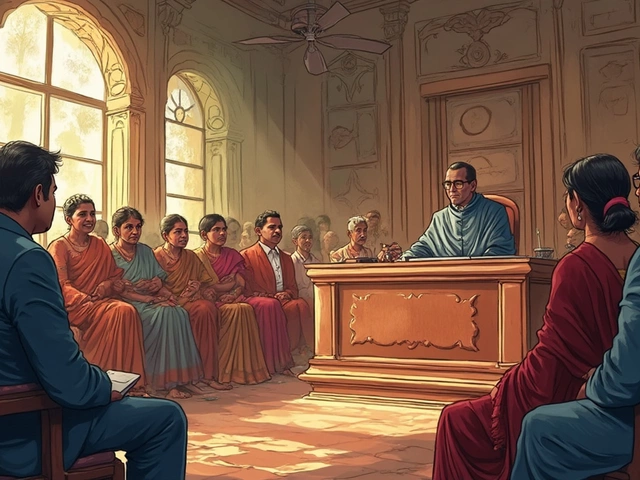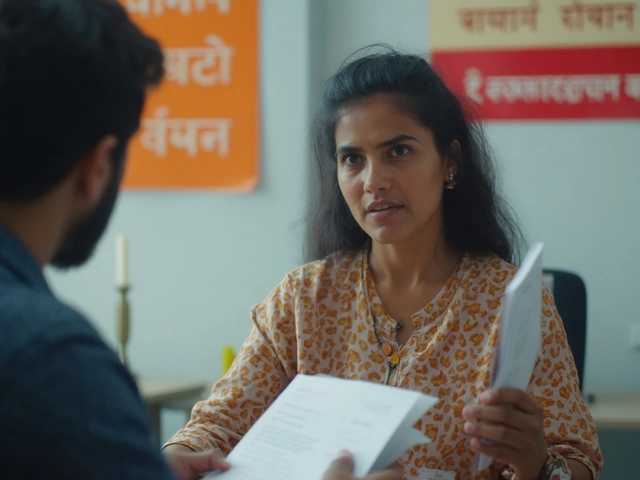If you’re an American planning to marry an Indian in India, the paperwork isn't just a formality—it's the real deal. Especially if you need the marriage to be recognized in both countries, you want to get every step right. Skip a document or sign the wrong form, and you could be bouncing between offices for months.
You’ll hit your first crossroads with the law: Special Marriage Act or Hindu Marriage Act? Americans usually have to get married under the Special Marriage Act, which means more paperwork and a longer waiting period (typically 30 days’ notice at the local registrar’s office). The Hindu Marriage Act is faster, but it's only for couples where both are Hindu, Sikh, Jain, or Buddhist by religion.
Proof of identity throws in surprises. The American partner—bring your passport, visa, and, if you’ve been married before, certified divorce or death certificates. Both of you will need proof of address, age, and passport-sized photos. And yeah, you’ll need at least three witnesses who aren’t shy about showing up and signing official papers.
The fun doesn’t stop at Indian paperwork. Want the marriage to count in the USA as well? After you get your Indian marriage certificate, you’ll need to get it apostilled at the Ministry of External Affairs, and sometimes officially translated too. A bit much? Maybe. But skipping these steps can really mess up everything from visa applications to your tax forms later on.
- The Legal Process: Two Laws, Double the Paperwork
- Documents You'll Need: Surprising Must-Haves
- Getting That Marriage Certificate: Timeline and Tips
- Common Pitfalls (and How to Dodge Them)
The Legal Process: Two Laws, Double the Paperwork
So here’s where things get tricky for an American marrying an Indian in India. You really need to know which law is going to handle your marriage registration. There are two main options: the Special Marriage Act (SMA) of 1954, and the Hindu Marriage Act (HMA) of 1955. Most mixed-nationality couples—especially if one is American—go through the SMA, so let’s break down why.
The SMA is designed to allow people of different nationalities or religions to legally marry in India. You can’t usually use the HMA unless both partners are openly Hindu, Sikh, Jain, or Buddhist. So unless you both tick those boxes, SMA’s your default.
For the SMA, here’s what actually happens:
- You both show up at the local marriage registrar office (in the area where one of you has lived for at least 30 days).
- You fill out the official “Notice of Intended Marriage” form and submit it with all your documents (identity, proof of residence, birth date, etc).
- The notice goes up on the office notice board for a full 30 days. This is basically to see if anyone objects to your marriage (yeah, it’s old school, but that’s how it works).
- If no one objects, you both come back on an agreed date with three adult witnesses for the ceremony and to sign the final register.
- You get a signed marriage certificate—this is your mega-important legal proof for everything, from visas to bank accounts.
With the HMA, the process is much faster—no 30-day wait. If you both qualify, you can do a religious ceremony and register it right after. But for most American-Indian couples, it’s SMA all the way, and that means patience and paperwork.
Now, while these steps sound basic, don’t ignore the wait times. In bigger cities, marriage registrar offices are slammed. That 30-day legal notice can turn into six weeks or more if you miss a document, so double-check everything before applying. Some states, like Maharashtra and Delhi, now let you start the process online but you’ll still have to visit in person for the actual marriage and signatures.
Here’s a quick look at the timelines:
| Step | Expected Time |
|---|---|
| Notice Period (SMA) | 30 days minimum |
| Document Verification | 1–2 weeks (can overlap with notice) |
| Marriage Registration Ceremony | 1 day |
| Issuance of Certificate | Few days to 2 weeks |
If you’re in a rush or on a tourist visa, ask about timelines at the registrar’s office—sometimes there are exceptions, but don’t bet your travel plans on it. Getting hitched in India as a cross-national couple isn’t impossible, but the marriage registration India process definitely tests your paperwork stamina.
Documents You'll Need: Surprising Must-Haves
Getting a marriage registration India when one partner is American means you're going to deal with more paperwork than most local couples. Trust me, forgetting even one paper can slow everything down. Here's what actually comes up every time—plus some stuff people don’t expect at all.
- Passport (with valid visa): For the American partner, this isn’t just suggested—it’s the main proof. Both sides need to show valid ID, but the American spouse will need to show entry and visa status, too.
- Address Proof: Usually, this means Aadhar, Voter ID, or local utility bills for the Indian partner. For Americans, it’s often your lease agreement, hotel bills, or embassy letter confirming your stay in India.
- Proof of Age: Birth certificate or any government ID that clearly spells out your date of birth.
- Passport Photos: Sounds basic, but most registrars want four to six copies, and if they're not the right size, you’ll get called back.
- Certificate of Single Status: This one almost always trips up Americans. You need a notarized and apostilled affidavit from the US saying you’re single—sometimes called 'no impediment' or 'single status' certificate. You’ll get this from the US embassy or a notary in America, but it has to be legalized for India.
- Divorce Decree or Death Certificate: If you've been married before, bring the original, and make sure it’s translated if not in English. Some officials won’t accept just photocopies.
- Notice of Intended Marriage: Under the Special Marriage Act, you fill this out and submit it 30 days before registration. Don’t leave it till the last minute.
- Three Witnesses: They need their own IDs and passport-sized photos. If they don't show up on the big day, you’re out of luck.
If you’re registering under the Special Marriage Act, expect the list to be checked twice and for people to nitpick on anything incomplete. Missing documents are the top reason why foreigners get sent home empty-handed the first time.
Quick tip: Some states want extra stuff, like a residence permit or a letter from your employer. It’s no joke—call the local marriage office ahead or better yet, go in person with a checklist.
Ever wondered how many applications get stuck? One count from the Delhi marriage office in 2023 showed nearly 25% of foreigner-Indian marriage applications were delayed because the affidavit of single status was missing or not apostilled. It’s small, but it matters.

Getting That Marriage Certificate: Timeline and Tips
Alright, so you want that official marriage registration India certificate in hand. Here’s what the real process looks like—no sugarcoating. If you’re two different nationalities, pretty much everyone ends up registering under the Special Marriage Act. That’s the one for mixed-nationality couples.
Here’s how it usually plays out:
- File a Notice of Intended Marriage: Both of you have to show up at the local marriage registrar’s office within the jurisdiction where at least one of you has lived for 30 days or more. You fill out the form together and submit your info.
- 30-Day Waiting Period: This is mandatory. The office will display your notice so objections (if any) can be filed—yep, you have to wait even if nobody minds. The clock starts only after the notice is posted.
- Submit Required Documents: Bring originals and copies of everything: passports, address proof, photos, age proof, divorce decree (if relevant), and three passport-sized photos each. Don’t forget your witnesses with their ID proofs, too.
- Day of the Marriage: After 30 days, you and your witnesses show up to sign the papers. Registrar asks you questions to confirm it’s all legit (basic stuff—you’re not being tricked into marriage or breaking any laws).
- Get the Certificate: If everything goes smoothly, you usually get your marriage certificate the same day or in a few days. Don’t leave without a hard copy; that’s your proof everywhere.
Here’s how the usual timeline shakes out:
| Step | Time Required |
|---|---|
| Notice Filing to Registrar | 1 day |
| Mandatory Notice Period | 30 days |
| Document Verification | 1-3 days |
| Marriage Registration Ceremony | 1 day |
| Certificate Issue | Same day or up to 7 days |
Tips for getting it right the first time:
- Bring extra copies and “just in case” docs. It’s not unusual for a clerk to want more than is listed on their website.
- Double-check spellings—one typo can mean weeks of delays.
- Make sure your address proof is current. Rental agreements, utility bills, or a notarized affidavit work best.
- Don’t forget your three witnesses. They need to show up in person with photo IDs. Family friends or colleagues who live locally work fine.
- If one of you is a foreigner, expect a little extra scrutiny—answer every question honestly. The registrar is just making sure everything’s legit.
- Once you have your marriage certificate, if you need to use it outside India (especially in the US), get it apostilled at the Ministry of External Affairs. Some US agencies only accept apostilled certificates.
Getting married in India isn’t exactly a cakewalk for mixed-nationality couples, but stay organized and don’t be afraid to ask the registrar lots of questions. It saves you time, money, and stress later.
Common Pitfalls (and How to Dodge Them)
Registering a marriage in India between an American and an Indian sounds easy until you run into the tripwires most folks don’t talk about. Honestly, even getting the documents together can eat up weeks if you’re not careful.
Biggest headache? Missing paperwork. Many couples forget the “No Objection Certificate” (NOC) that’s often demanded from the American’s embassy. Without this, the registrar will turn you away flat, no matter how much you plead. Also, if the American is divorced, original divorce decrees (certified and apostilled) are a must. Photocopies won’t cut it.
Here’s a reality check: India’s marriage registration laws are big on witnesses. You need three, and not just friends—witnesses must have valid ID (usually an Aadhaar Card or passport for Indians, sometimes PAN Card for extra proof). If your witnesses ditch you last-minute, your appointment will fall apart.
- Wrong address proofs: Registrars can be really picky about this. For Americans, hotel bookings or Airbnb printouts won’t be accepted. Try to arrange a formal residence proof like a utility bill, rent agreement, or an employer letter.
- Mismatched names: If any of the names in your documents don’t match (like a missing middle name, extra space, or different spellings), expect delays. Double-check every form before submission—even a small error can push your case back by weeks.
- Timing slip-ups: The Special Marriage Act requires you to be present in India for a 30-day notice. Heading to India thinking you can register and fly out in a week? Not happening. The registrar actually puts your marriage notice up on the office board for those 30 days to allow for objections.
This table shows how long typical issues can delay things—
| Problem | How Long It Delays Process |
|---|---|
| Missing Embassy NOC | 1-2 weeks at least |
| Name mismatches | Varies, usually 1-3 weeks to resolve |
| Wrong witnesses or IDs | Can require new appointment (2-4 weeks) |
| Short visa stay | You might have to start over from scratch |
Another tip: While offices do work online more now, most registrars still require both partners to be physically present for the actual marriage (and to sign the register in front of the registrar). Remote approvals just don’t happen.
So if you want your American Indian marriage registration to go smoothly, double-check every single doc, bring plenty of ID copies, and plan for a couple of extra weeks, just in case. A little prep can save a lot of pain.


